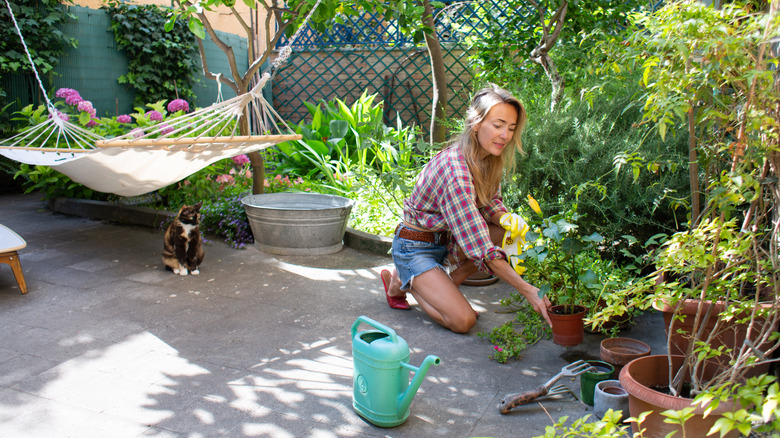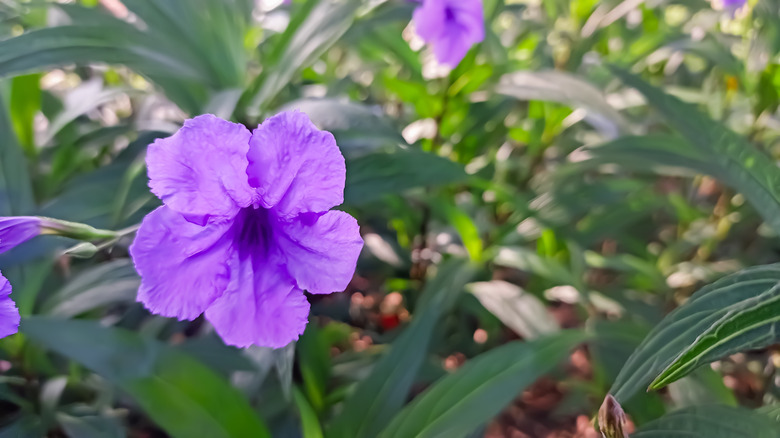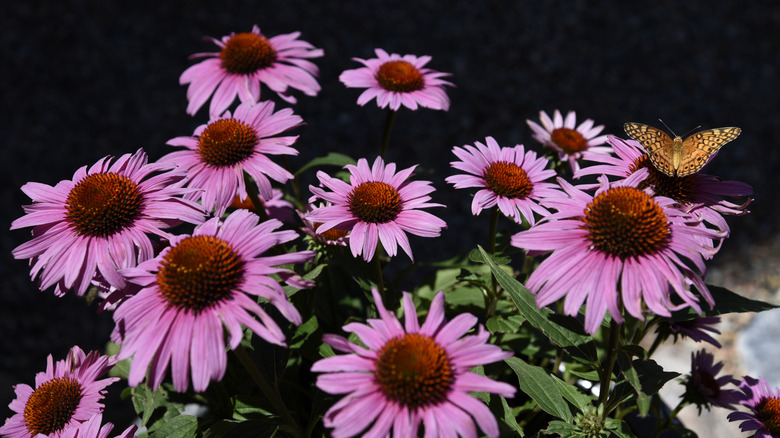The Stunning Purple Flower That Thrives In Late Summer Heat
Worried that it's too hot or too late in the season to plant flowers in your garden? Spoiler alert: It's not. There are a number of eye-catching plants that won't just survive in late summer heat — they'll thrive. If you're a fan of purple, bump Mexican petunias (Ruellia simplex) to the top of your list. This stunning perennial plant features woody, dark-green leaves and pink, white, lavender, or purple blooms that love heat, humidity, and lots of sunshine. Contrary to what the name suggests, it's not actually from the same family of plants as petunias (Petunia); it just resembles them. Mexican petunias are native to the Americas and and grow well in Hardiness Zones 8 to 11. You can also plant it as an annual in colder climates.
There are a few potential drawbacks to be aware of before planting Mexican petunias in your garden. It can be a very aggressive grower that can damage local ecosystems in some parts of the U.S. But if you're in a region where Mexican petunias won't impact the growth of native flora? Then it's an excellent pick for late-summer blooms.
How to plant and tend to Mexican petunias
Mexican petunias spread super easily through rhizomes and self seeding. In fact, in Florida, it's listed as an invasive plant you should never grow. Even if you live in regions where these flowers are not invasive, be aware that they may take over your garden. That said, they also thrive in containers and potting them is one way to curb their aggressive spreading habit.
As far as planting and care goes, though, Mexican petunias aren't fussy, especially in hot climates, where they're often evergreen. They can be planted easily from seeds or cuttings or repotted. They need full sun to thrive, so choose a spot that gets plenty of light throughout the day. Once established, this plant can handle droughts and high heat (though, notably, it does poorly in the cold). These flowers are also unappealing to deer, so you don't have to worry about damage. It does best in moist, well-drained soil, whether that's in a garden bed or a container on your patio. Grown in the ground, it can reach heights of 3 feet.
Less-aggressive alternatives to Mexican petunias
If you're not sold on Mexican petunias, or you live in Florida, where this plant has been classified as invasive, opt for a different flowering plant that also thrives in summer heat. Sun-loving purple coneflowers (Echinacea purpurea) could work well. Not only is this pretty perennial flower heat resistant, durable, and famously easy to grow, it's also a native prairie wildflower that's beloved by pollinators and can attract both hummingbirds and butterflies. It does well in a wider range of hardiness zones, too (3 to 9), so it's more suitable for a different climates and weather conditions throughout the United States. (As a bonus, the purple coneflower population is critically imperiled in some southern states, including Florida, where they've suffered as a result of large-scale habitat loss — plant them there, and you'll be doing a public service for your local ecosystem.)
There are also wild petunias (Ruellia humilis), a hardier, more shade-tolerant alternative to Mexican petunias. Commonly found in prairies throughout the United States, this flowering plant comes recommended by the Florida Wildflower Foundation as a safer, native option. Lastly, marigolds (Tagetes) are another popular pick among home gardeners that's known for high heat tolerance. This eye-catching flower boasts bright red or orange blooms that will keep your garden looking full and flowery well into fall. Like coneflowers, marigolds fare best in full sun and are fairly low maintenance. However, marigolds are annuals, so you'll need to replant it in your garden next summer if you want to enjoy it again. Plant this flower in a well-drained garden bed or pot.


